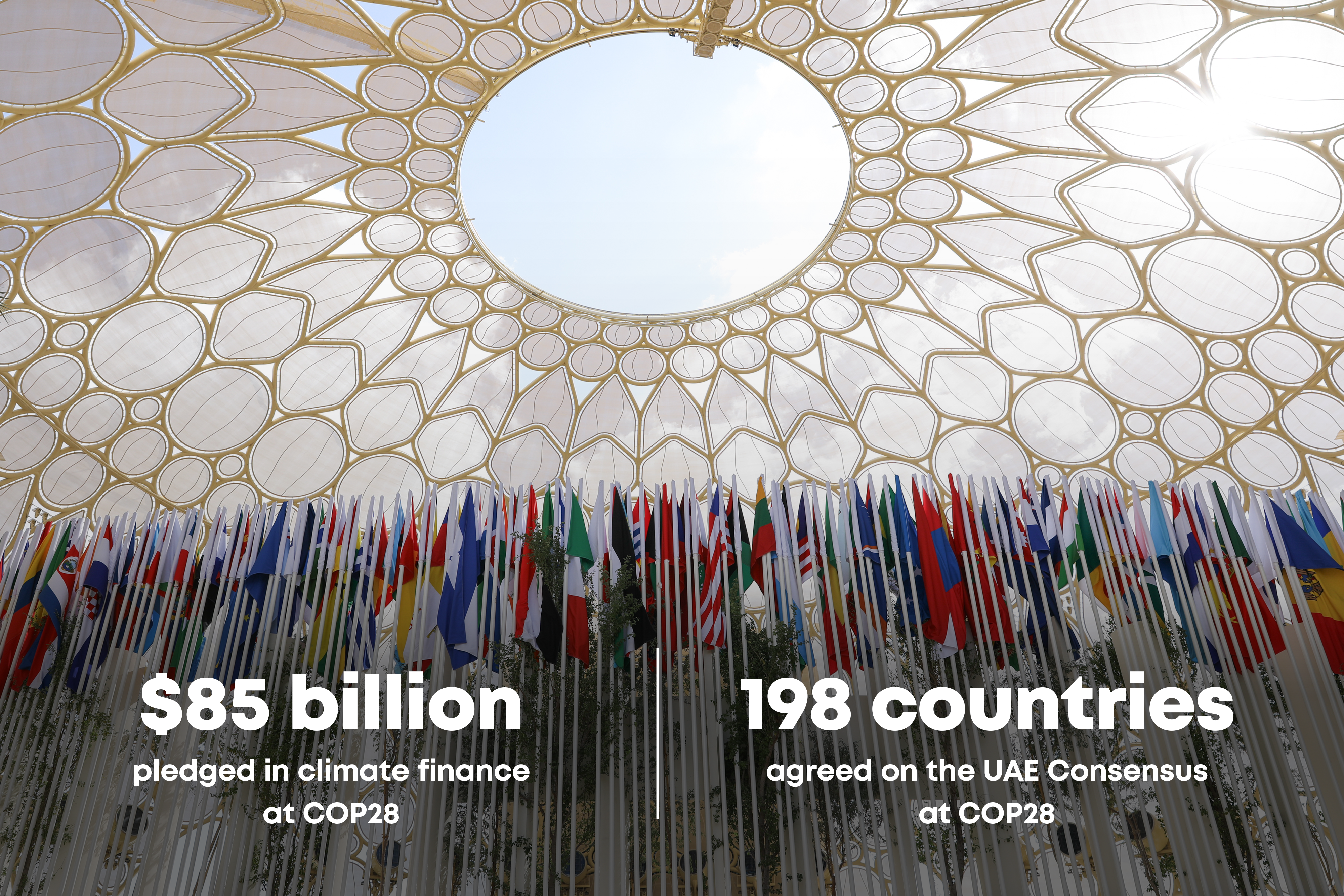Explained: what happens next after historic UAE Consensus at COP28?
The COP28 climate summit in Dubai made history on Wednesday when 198 nations agreed to a long-term transformation of the global energy economy and set a deadline of tripling renewable energy capacity by 2030 – marking the first time such an agreement has been reached in nearly three decades of United Nations-led international climate negotiations.
The commitment to transition away from fossil fuels forms part of the first ever Global Stocktake (GST) of the landmark Paris Agreement of 2015, that set out to determine how the world can accelerate action to meet the goals of keeping global warming restricted to 1.5C.
In his concluding speech after the historic vote at the final COP28 plenary, COP28 President Dr. Sultan Al Jaber hailed the landmark GST agreement as the “UAE Consensus” and said: “The world needed to find a new way. By following our North Star, we have found that path. We have worked very hard to secure a better future for our people and our planet.”
What is the UAE Consensus?
The first Global Stocktake (GST) or the UAE Consensus is a comprehensive agreement signed by 197 nations and the European Union that paves the way – among other objectives – for a transition away from fossil fuels, triple renewables and double energy efficiency by 2030, and usher in a new architecture for climate finance to achieve net zero by 2050.

The COP28 Presidency’s approach to deliver the UAE Consensus was based on four pillars of the Paris Agreement: fast-tracking a just energy transition, fixing climate finance, focusing on people and nature, and fostering inclusivity in climate action. According to early estimates, the UN climate summit in Dubai helped mobilise an unprecedented $85 billion in funding for climate action.
What did 198 countries agree to at COP28?
The headline-grabbing agreement of the COP28 declaration is the provision that calls for “transitioning away from fossil fuels in energy systems, in a just, orderly and equitable manner, accelerating action in this critical decade, so as to achieve net zero by 2050 in keeping with the science”.
Other commitments in the UAE Consensus include:
- Tripling renewable energy capacity globally and doubling the global average annual rate of energy efficiency improvements by 2030
- Rapidly phasing down unabated coal and limitations on permitting new and unabated coal power generation
- Accelerating and substantially reducing non-CO2 emissions, and in particular methane emissions globally by 2030
- Accelerating emissions reductions from road transport through a range of pathways, including development of infrastructure and rapid deployment of zero and low emission vehicles
- Phasing out of inefficient fossil fuel subsidies that encourage wasteful consumption and do not address energy poverty or just transitions, as soon as possible
- Accelerating the deployment of low-emission technologies, including nuclear energy, to help achieve rapid decarbonisation through low-carbon hydrogen.
Overall, the final text of the agreement – reached after a fortnight of hard-fought negotiations that took COP28 to extra time on Wednesday – seeks to strike a balance between emission targets, energy security and access, and global economic development, underscoring the complexity of the energy transition and the pathway to achieving net zero by 2050.
What does the COP28 agreement say on the role of carbon capture?
One of the notable inclusions in the final agreement of COP28 is the role of carbon capture technologies in reducing emissions and leaving a positive impact on climate change.

The agreement calls for “accelerating zero- and low-emission technologies, including, inter alia, renewables, nuclear, abatement and removal technologies such as carbon capture and utilisation and storage,” – the first such acknowledgment as part of the COP process that such technologies could enable more efficient and environment-friendly operations for the oil, natural gas and coal industries.
How have been the reactions from governments and the industry?
US President Joe Biden welcomed the historic COP28 agreement and said: “World leaders reached another historic milestone … while there is still substantial work ahead of us to keep the 1.5°C goal within reach, today’s outcome puts us one significant step closer”.
His comments echo the general sentiment around the world with most leaders agreeing that the UAE Consensus sends a very strong message of progress on climate action. Wopke Hoekstra, the EU's climate commissioner, said it was a day of “gratitude and of silent determination,” while Jennifer Morgan, Germany’s climate envoy, also hailed a “historic decision”.
Among the earliest declarations of COP28 was the landmark Oil and Gas Decarbonisation Charter (OGDC), a high-impact global industry initiative to accelerate climate actions so far supported by 52 companies. Haitham Al Ghais, Secretary General for OPEC, and Mohamed Hamel, Secretary General for the Gas Exporting Countries Forum (GECF), underlined the critical role of the energy industry in achieving a low-carbon future. “The oil and gas industry will play a constructive and critical role in sustainable development and poverty eradication, while contributing to a just, orderly and inclusive energy transitions, in particular through enhancing efficiencies and developing and deploying advanced technologies, such as carbon capture utilisation and storage (CCUS),” they said in a statement.
What other agreements were announced at COP28?
Among a host of other initiatives announced at COP28 were operationalising the Loss and Damage Fund with contributions from several stakeholders; mobilised more than US $85 billion in new financial commitments for climate action; the launch of ALTÉRRA, the world’s largest catalytic private investor that is 100 percent focused on solutions to climate change; and declarations on agriculture, food and health to pave the way for net-zero by 2050.
What happens now after the COP28 agreement?
With its focus on tackling emissions, bridging the gap on adaptation, and reimagining global climate finance, the UAE Consensus at COP28 keeps the goal of limiting global warming to 1.5C within reach. The focus will now move to the even more tough part – how to curb emissions by nearly in half in just six years, and to net zero by 2050.
In a world where oil, gas, and coal account for about 80 per cent of the energy, natural gas – long considered a transitional fuel due to its lower emissions – could emerge with a bigger mandate as the industry pursues the road to net zero by 2050.

What will be on the agenda at COP29 and COP30?
COP28 was not only the largest climate summit ever staged with more than 80,000 registered attendees, but also a vindication of the multilateral process mandated by the United Nations Framework Convention on Climate Change (UNFCCC), where all stakeholders must agree to a potential deal.
Countries will now focus on delivering their national policies and investments while preparing for COP29 in Azerbaijan, followed by COP30 in Brazil. Dr Sultan Al Jaber succinctly summed it up in his speech at the final plenary of COP28: “Together, we will follow our North Star. We will follow it from here to Baku and from Baku to Belem. And together, we will secure the future of this beautiful planet for the many generations to come.”
KEEPING THE ENERGY INDUSTRY CONNECTED
Subscribe to our newsletter and get the best of Energy Connects directly to your inbox each week.
By subscribing, you agree to the processing of your personal data by dmg events as described in the Privacy Policy.
















